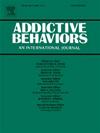性少数群体青少年的非法药物使用及相关健康风险行为
IF 3.6
2区 医学
Q1 PSYCHOLOGY, CLINICAL
引用次数: 0
摘要
目的探讨青少年终生非法药物使用(如可卡因、致幻剂、摇头丸、海洛因)与近端健康风险行为之间的关系,并探讨性别认同在其中的调节作用。方法:我们分析了疾病控制中心2021年青少年风险行为调查(N = 17,232)的数据,这是一项两年一次的横断面调查,调查对象是美国9年级至12年级的全国代表性样本。使用加权数据的双变量表来估计终身非法吸毒者和性少数青年(女同性恋、男同性恋、双性恋、质疑性取向或其他性身份(LGBQ+))中健康风险行为的流行程度。结构方程模型被用来检验它们之间的关联。效应修正采用Wald检验。结果非法药物使用与青少年广泛的健康风险行为相关(例如,吸烟和大麻使用,饮酒和驾驶,性行为前使用酒精和药物,以及拥有多个性伴侣)。终生非法药物使用与性身份之间存在显著的相互作用,因此曾经从事非法药物使用的LGBQ+青年发生健康风险行为的几率最大。结论:有非法药物使用史的青少年可能会有各种各样的健康风险行为。对这些健康风险行为进行筛查和提供咨询,可能在确保将青少年,特别是LGBQ+青少年的吸毒后遗症降至最低方面发挥关键作用。本文章由计算机程序翻译,如有差异,请以英文原文为准。
Illicit drug use and associated health risk behaviors among sexual minority youth
Objective
This study examined the links between lifetime illicit drug use (e.g., cocaine, hallucinogens, ecstasy, heroin) and proximal health risk behaviors among adolescents and investigated sexual identity as a moderator.
Methods
We analyzed data from the Center for Disease Control’s 2021 Youth Risk Behavior Survey (N = 17,232), a biennial, cross-sectional survey of a nationally representative sample of youth enrolled in grades 9 through 12 in the United States. Bivariate tabulations of weighted data were used to estimate the prevalence of health risk behaviors among lifetime illicit drug users and sexual minority youth who identified as lesbian, gay, bisexual, questioning, or another sexual identity (LGBQ+). Structural equation modeling was used to examine their associations. Wald testing was employed to test for effect modification.
Results
Illicit drug use was associated with a broad range of health risk behaviors among adolescents (e.g., cigarette and marijuana use, drinking and driving, use of alcohol and drugs before sex, and having multiple sex partners). There was a significant interaction between lifetime illicit drug use and sexual identity such that LGBQ+ youth who have ever engaged in illicit drug use had the greatest odds of health risk behaviors.
Conclusions
Adolescents with a history of ever using illicit drugs are likely to engage in a wide array of health risk behaviors. Screening and offering counseling on these health risk behaviors may play a crucial role in ensuring that the sequela of drug use among adolescents is minimized, especially for LGBQ+ youth.
求助全文
通过发布文献求助,成功后即可免费获取论文全文。
去求助
来源期刊

Addictive behaviors
医学-药物滥用
CiteScore
8.40
自引率
4.50%
发文量
283
审稿时长
46 days
期刊介绍:
Addictive Behaviors is an international peer-reviewed journal publishing high quality human research on addictive behaviors and disorders since 1975. The journal accepts submissions of full-length papers and short communications on substance-related addictions such as the abuse of alcohol, drugs and nicotine, and behavioral addictions involving gambling and technology. We primarily publish behavioral and psychosocial research but our articles span the fields of psychology, sociology, psychiatry, epidemiology, social policy, medicine, pharmacology and neuroscience. While theoretical orientations are diverse, the emphasis of the journal is primarily empirical. That is, sound experimental design combined with valid, reliable assessment and evaluation procedures are a requisite for acceptance. However, innovative and empirically oriented case studies that might encourage new lines of inquiry are accepted as well. Studies that clearly contribute to current knowledge of etiology, prevention, social policy or treatment are given priority. Scholarly commentaries on topical issues, systematic reviews, and mini reviews are encouraged. We especially welcome multimedia papers that incorporate video or audio components to better display methodology or findings.
Studies can also be submitted to Addictive Behaviors? companion title, the open access journal Addictive Behaviors Reports, which has a particular interest in ''non-traditional'', innovative and empirically-oriented research such as negative/null data papers, replication studies, case reports on novel treatments, and cross-cultural research.
 求助内容:
求助内容: 应助结果提醒方式:
应助结果提醒方式:


